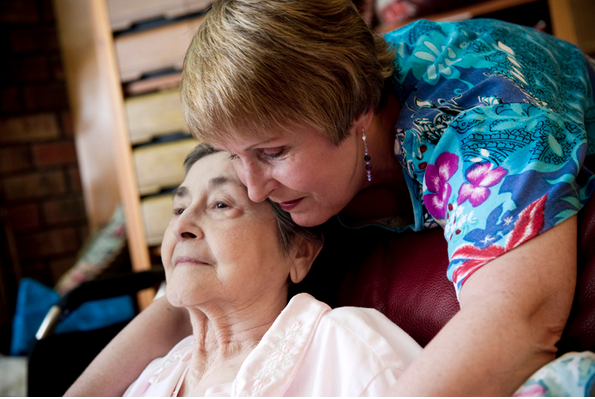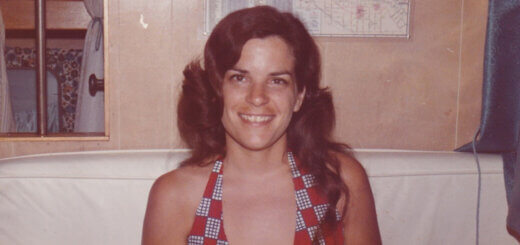Difficult behaviors: bathing and personal hygiene
As with most things related to Alzheimer’s caregiving, dealing with behavioral symptoms requires planning, simplification and patience. As Alzheimer’s progresses, poor hygiene can become an issue: people living with dementia (PLWD) may refuse to bathe and it can have medical consequences, such as urinary tract infections (UTIs).
Because Alzheimer’s causes a slow decline of cognitive functions, a PLWD will start to get confused about seemingly simple things, like how to wash their hair. A PLWD may be overwhelmed and confused by all the products on the bathroom counter, perhaps mistaking a tube of lotion for toothpaste. If the PLWD doesn’t always recognize themselves or their loved ones, the images they see in the mirrors may be confused as strangers.
Sensory perception, especially vision, touch and smell, also changes. This can make a tub of water seem scary as depth perception changes. A smelly shirt may be more comforting than a freshly laundered – but unfamiliar – replacement. Room or water temperature may feel different to the PLWD than it does to us.
Trying to understand that a PLWD’s perceptions are increasingly distorted by the disease’s progression, and focusing on creating positive routines, may help caregivers get through difficult behaviors.
Bathing and hygiene
Focus on what has to be done to keep a PLWD healthy while maintaining their dignity. Most PLWDs don’t need to bathe or shower every day as long as there is good hygiene after toileting and genitals are cleaned daily. Keeping wet wipes handy in the bathroom is an easy way to promote hygiene – and consider having them in a warmer.
A bath or shower should be quick and efficient but not rushed. Bathing should occur in the manner that the person is accustomed to (shower vs. bath) and at the time of day they are used to.
Preparing for bathing
Rewards can be helpful – “We’ll have some ice cream after the shower.” Be aware of your wording; if the word “˜shower’ triggers resistance, use the words “˜cleaned up.’
Don’t ask if they want to have a shower; most questions result in the answer no. Instead use a gentle command: “Let’s get cleaned up and then we can go for a drive.” You can connect bathing to another personal care activity such as toileting or getting dressed since the PLWD will already be partially undressed.
Prepare the bathroom ahead of time – it will make it more comfortable for the PLWD and you will be more prepared. The sight and sound of running water may be frightening so have the bath drawn or the shower already at the correct temperature. Have your products and towels handy; warm towels are a welcome treat.
Consider using these safety equipment items:
- Non-skid safety mat
- Grab bars
- Shower bench or chair, or a transfer bench.
During bathing
Simplify the process by using combination body wash and shampoo and only have what you need in the shower. You can wash hair less frequently and use a dry shampoo instead. Cover mirrors if necessary.
If using a shower, use a hand-held showerhead so that the water isn’t spraying down on the PLWD’s head and face. Having some calming music can be helpful, even singing favorite tunes.
Aromatherapy or other scents can make the bathroom feel like a spa; in fact, many family members report that they will tell the PLWD that it’s their spa day when it’s bathing day. Have a comfy robe and fluffy towels nearby and the room temperature kept warm.
Give the PLWD a washcloth or sponge and have them involved in the cleaning process; this helps give them a sense of control. Telling them what you are about to do can also be helpful. Some partners take a shower together and the PLWD may be able to mimic the cleaning motions.
After bathing
Ensure the PLWD is completely dry and use lotion or cornstarch, especially under skin folds for skin health. On days where a bath or shower doesn’t take place, substitute with a sponge-bath or warm wet wipes.
Often, PLWD don’t want to change their clothes because of the familiarity of them. Buy duplicates of favorite clothes, so you can wash a set at a time. Offer fewer clothing choices, compliment them on how they look in their outfits, and provide comfortable, simple clothing and shoes (slip-on pants, clothes and shoes with big buttons, snaps or Velcro closures).
Other bathing information
Bathing is a private activity and it’s understandable that a PLWD may feel vulnerable or uncomfortable when being bathed by someone else, even a family member. There may be issues related to the lack of privacy, especially relating to exposure of genitals. It may be helpful to have someone of the same sex assist a PLWD with bathing or cover genitals with a washcloth during a bath. There are even bathing dignity capes that can be used.
Know that these techniques won’t always work but they are well worth a try. For one family bathing was extremely challenging. What worked for them was to take the PLWD for a supervised swim in the family swimming pool. The PLWD still loved being in the pool so they were happy and clean.
More suggestions for bathing care, including safety tips, can be found on the Alzheimer’s Association website’s bathing section.
Don’t forget dental care
Dental care is essential for good general health and a daily routine of dental care is still important for a PLWD. We often don’t think much about brushing our own teeth but when it is done for you, it’s a whole different experience.
Dental care shouldn’t be rushed and it’s a good time to evaluate the PLWD’s mouth for health issues – look for signs of dry mouth, bleeding or any mouth pain.
You can use toothpaste, but you don’t have to. Use a brush with soft or ultra-soft bristles; kid’s toothbrushes are often helpful because of their softness and smaller size. Electric toothbrushes may be less frightening to the PLWD.
Three methods to try:
- Brush their teeth yourself
- Use the hand-over-hand technique
- Use the “watch me” technique.
Hand-over-hand technique
With hand-over-hand, the PLWD is holding the toothbrush and you provide guidance by holding your hand over theirs and helping with the brushing motions.
“Watch me” technique
With the “watch me” technique, you brush your teeth with them and they will mimic your actions. Providing short, clear, step-by-step instructions may also help.
Clean dentures daily and attempt flossing by using a floss holder or picks. You can ask the dentist about anti-microbial rinses although it’s important to be aware that the PLWD may swallow the mouthwash and, if they are having swallowing issues, mouthwash is not an appropriate strategy. Minimize products on the counter to reduce confusion.
Try to continue regular dental check-ups and see if there is a dentist in your area that specializes in patients with special needs. When you do go to the dentist, make sure the dentist and staff know that the person struggles with dementia.
Final notes on hygiene
If you can establish a daily routine around hygiene, keeping it simple and as pleasant as possible, you will have a better chance of getting through it with your humor and the PLWD’s dignity intact.
Try and see things through a PLWD’s Alzheimer’s lens – which means, don’t expect your reasoning to matter. Just take a breath, smile”¦ and try again later! If it never seems to work out, you might want to consider a home care aide for bathing assistance.
And don’t forget to pour yourself a nice bubble-bath and soak some of that caregiver stress away as well!
Helpful information related to this story
Alzheimer’s Association Caregiver Center
Living with Alzheimer’s disease
The stages of Alzheimer’s disease
More caregiver tips on our blog
Blog written by Alzheimer’s Association Volunteer Diane Blum



















Considerable difficulty getting PWD to be willing to shower. Previously PWD was very well groomed and interested in appearance. Becoming a major issue at nursing home.
Need help badly
Please call our helpline at 800.272.3900 – staff can assist with ideas to help.